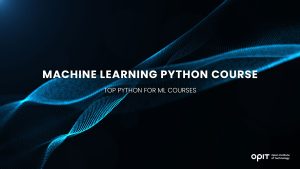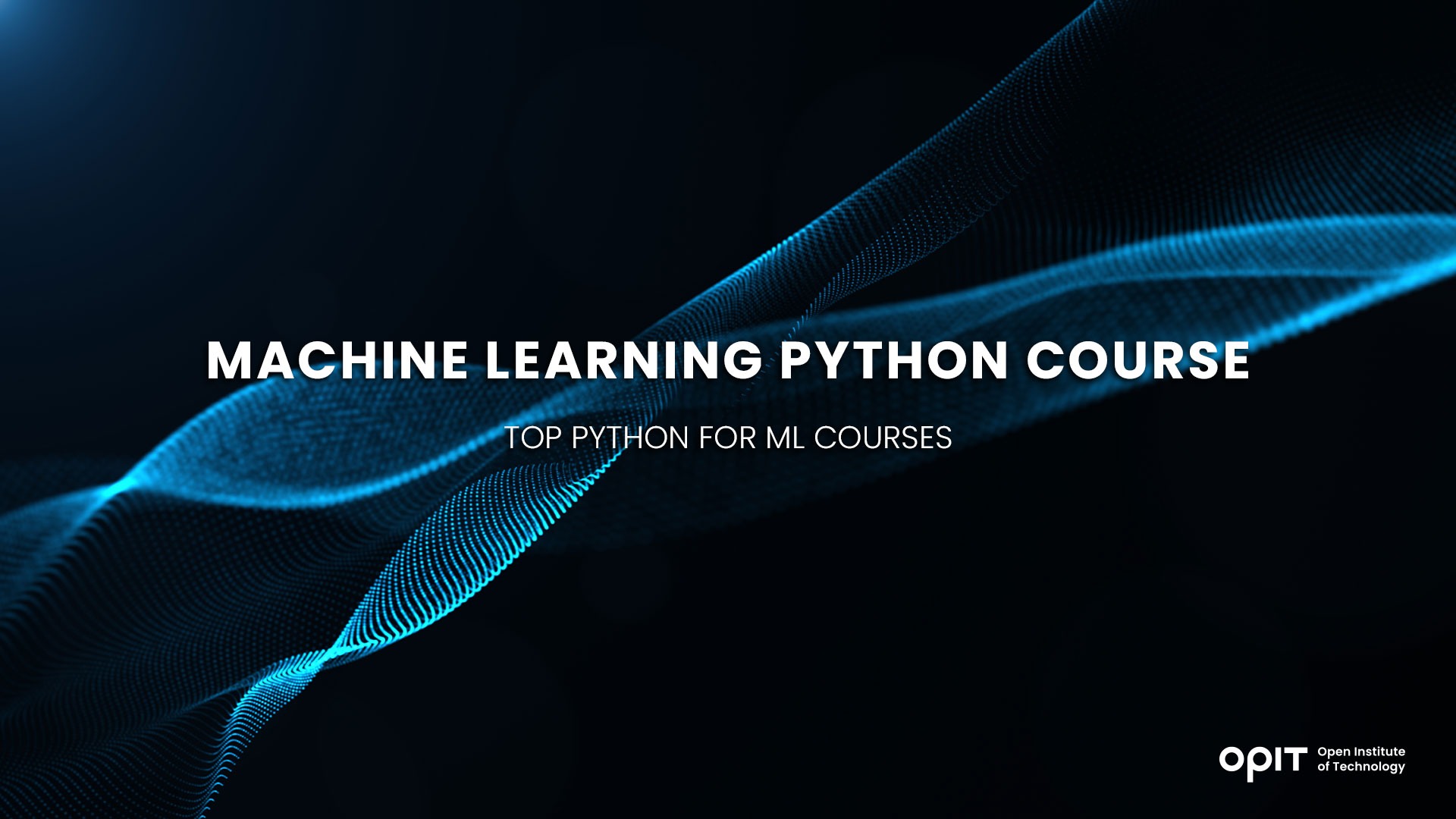

Machine learning (ML) is a branch of artificial intelligence (AI) that focuses on enabling computers to “think” for themselves. Of course, they owe this thinking to humans (data scientists and ML engineers) who continuously supervise ML algorithms and models.
So, there’s no AI takeover (for now at least), just incredible ways to propel several industries forward by automating repetitive tasks, extracting valuable insights from data, and improving decision-making processes.
But how do humans precisely communicate with computers in machine learning?
The answer is through programming languages.
One programming language stands out among the rest for its simplicity and versatility. By the title of this guide, you can already guess we’re talking about Python.
This beloved programming language is all over the machine learning field, so mastering it gives you a great head start in the industry.
With this in mind, let’s examine how you can learn Python for machine learning courses. If you already have some basic knowledge of this programming language, don’t worry. We’ll also mention a great machine learning Python course to take your knowledge to the next level.
Factors to Consider When Choosing a Python for ML Course
Do a Google search for “machine learning Python course,” and you’ll be met with dozens of web pages that promise a sound understanding of this programming language. However, you’ll find the best course for your needs if you can identify those needs first.
Course Content and Curriculum
Your chosen course’s curriculum is arguably the most important factor for selecting the perfect machine learning Python course. One look at the listed topics, and you’ll know whether the course is right for you.
Let’s take your previous experience with Python as an example. If you have none, a course that jumps straight into machine learning algorithms without covering the Python basics will obviously not work for you.
Instructor’s Expertise and Experience
What bridges the gap between struggling to comprehend a complex subject and feeling that nothing can stop you in your learning journey? The answer is simple – a good instructor.
Before committing to a course, check who teaches it. Find out the instructor’s background with Python and whether they have enough expertise to guide you through this programming language’s intricacies.
If their bio checks all the boxes, watch at least one of their lectures. It doesn’t hurt to check whether their teaching style and voice suit you, as these can also make or break your learning experience.
Course Duration and Flexibility
Most online courses are self-paced, allowing you to create your own schedule. Fixed-timing courses also have their benefits, though. They’re usually instructor-led, so you can use the opportunity to ask questions and receive clarification as you learn the material.
As for duration, the course’s description typically indicates how long the course lasts and the recommended pace. Before starting, make sure you can commit to the course from beginning to end. Otherwise, you’re just wasting time and gaining incomplete knowledge.
Hands-On Projects and Real-World Applications
Programming languages are inherently practical, so ensure that your chosen course features hands-on projects and practical examples. Sticking solely to theory will do little to prepare you for what’s waiting in the real world.
Course Reviews and Ratings
You probably check reviews before going to a new restaurant, renting an Airbnb, or purchasing clothes online. So why should shopping for online courses be any different? When a course piques your interest, check how other learners have rated it. But don’t stop at glancing at the average rating. Read through some reviews to ensure they aren’t fake and to get a better picture of the course’s quality.
Pricing and Value for Money
There are plenty of free machine learning resources online. But the more advanced courses and certificates usually come with a fee. And that’s perfectly understandable. What’s not understandable or acceptable are courses that charge ridiculously high fees yet offer little value. To avoid wasting money (and probably time), check whether the course’s price is justifiable by its duration, level, type, and provided support.
Top Python for ML Courses Reviewed
Here are our favorite Python courses primarily focused on machine learning. We’re positive you’ll find the perfect machine learning Python course, whether this is the first time you use this programming language or want to master this skill.
Python for Machine Learning
The Python for Machine Learning course on Great Learning is a great place to start your Python-learning journey. This course is beginner-friendly and relatively short, so you won’t get overwhelmed from the get-go.
This course focuses on three Python libraries: NumPy, Pandas, and Matplotlib. It guides you through the basic concepts (arrays, intersection, loading, etc.) and then moves on to more complex functions. At the end of the course, you take a quiz. Pass the quiz, and you’ll get a certificate of completion.
Applying for this course is free. Not only that, but you’ll also receive free lifetime access, so you can revisit the course whenever you’d like. Although, some learners believe that there’s little to revisit. In total, this course lasts for 90 minutes. Those who are serious about Python learning will probably need more than this.
Still, you can view this course as a beginner’s guide and move to more advanced lessons afterward. To apply, you only need to create an account on the platform and send an enrollment request.
Machine Learning A-Z: AI, Python & R
If you want to start with the basics but cover the more advanced stuff within the same course, this Udemy’s gem is for you. It covers another programming language besides Python, R. However, this won’t be an issue, as you can focus solely on Python.
The course is broken into 10 parts, with over 40 hours of on-demand videos. Each section (and even the lessons within them) is separate, so you can choose to complete the ones that will benefit you now. Start with data preprocessing, and work toward machine learning model selection.
Those seeking practical exercises in Python will love this course. However, you might need to research some notions independently, as not all lecture sections are explained in great detail.
You can purchase lifetime access to this course for $89.99 (a little over €83). The price includes a certificate of completion and several additional learning materials (articles and downloadable resources). Complete the purchase to apply for this course.
Machine Learning With Python by IBM
IBM is one of the leading companies in the machine learning field, so you should take advantage of every chance to learn from its experts. If you’re just gaining your footing in machine learning, you’ll cover all your bases with this offering.
It will take approximately 12 hours over four weeks to complete the coursework. After each lesson, you’ll get a chance to put your newly-learned knowledge to the test.
One thing to keep in mind is that this course focuses more on machine learning using Python than the programming language itself. So, if you’ve never worked with Python, an additional resource or two might come in handy.
You can use Coursera’s 7-day trial to enroll in this course. Afterward, you’ll be charged $39 (approximately €36) a month. The same fee is a must if you want to receive a certificate.
The Complete Machine Learning Course With Python
Are you a data scientist in the making looking to build a solid portfolio with Python? If yes, you’ll love this course. You can find it on Udemy, just like millions of learners before you. This number might surprise you at first. But once you see that one of the founders of this course is Andrew Ng, a thought leader in machine learning, it will make much more sense.
In 18 hours, this course covers all the basics of machine learning with Python. But there’s a catch. You’ll need at least basic Python programming knowledge to keep up.
If this isn’t an issue, create an Udemy account and pay the $59.99 (around €55.50) fee to apply. Lifetime access and a certificate of completion are included.
Programming for Everybody (Getting Started With Python)
While not focused on machine learning per se, this course is necessary for anyone who has yet to work with Python. Pair it with one of the other courses on our list, and your success is guaranteed.
As the name implies, this course covers all the basics. It is designed to allow virtually anyone to follow, regardless of their skills. The simplest math is all you need.
You’ll also need 19 hours to complete this course offered by the University of Michigan. However, the instructor snuck a couple of non-Python-related stories into those 19 hours, which some learners didn’t like.
If you don’t mind a break here and there, join this course on Coursera for free or $49 (a little over €45) if you want a certificate.
Additional Resources for Learning Python for Machine Learning
Perhaps you can’t get enough of learning about Python. Or you find Python for machine learning courses lacking information. Whatever the case, you can find additional resources (both online and offline) to help you master this programming language. Check out some of our favorites:
- Books and e-books: “Python for Data Science, for Dummies,” “Introduction to Machine Learning with Python: A Guide for Data Scientists,” “Python Data Science Handbook: Essential Tools for Working with Data”
- Blogs: Planet Python, Real Python
- YouTube channels: IBM Technology, Google Career Certificates, techTFQ
- Community forums and discussion groups: Kaggle Discussions, Reddit (r/learnpython)
The Path to Python
As you can see, there’s no shortage of Python for machine learning courses, even hosted by some of the biggest names in the industry. Take one of the listed courses or combine them; the choice is all yours. All that matters is that you ultimately master this programming language and crush any data science career you choose.
If these courses aren’t enough to quench your thirst for knowledge, a Bachelor’s in Modern Computer Science will definitely do the trick. With it, you can learn all the ins and outs of Python and machine learning in general.
Related posts

Source:
- The Yuan, Published on October 25th, 2024.
By Zorina Alliata
Artificial intelligence is a classic example of a mismatch between perceptions and reality, as people tend to overlook its positive aspects and fear it far more than what is warranted by its actual capabilities, argues AI strategist and professor Zorina Alliata.
ALEXANDRIA, VIRGINIA – In recent years, artificial intelligence (AI) has grown and developed into something much bigger than most people could have ever expected. Jokes about robots living among humans no longer seem so harmless, and the average person began to develop a new awareness of AI and all its uses. Unfortunately, however – as is often a human tendency – people became hyper-fixated on the negative aspects of AI, often forgetting about all the good it can do. One should therefore take a step back and remember that humanity is still only in the very early stages of developing real intelligence outside of the human brain, and so at this point AI is almost like a small child that humans are raising.
AI is still developing, growing, and adapting, and like any new tech it has its drawbacks. At one point, people had fears and doubts about electricity, calculators, and mobile phones – but now these have become ubiquitous aspects of everyday life, and it is not difficult to imagine a future in which this is the case for AI as well.
The development of AI certainly comes with relevant and real concerns that must be addressed – such as its controversial role in education, the potential job losses it might lead to, and its bias and inaccuracies. For every fear, however, there is also a ray of hope, and that is largely thanks to people and their ingenuity.
Looking at education, many educators around the world are worried about recent developments in AI. The frequently discussed ChatGPT – which is now on its fourth version – is a major red flag for many, causing concerns around plagiarism and creating fears that it will lead to the end of writing as people know it. This is one of the main factors that has increased the pessimistic reporting about AI that one so often sees in the media.
However, when one actually considers ChatGPT in its current state, it is safe to say that these fears are probably overblown. Can ChatGPT really replace the human mind, which is capable of so much that AI cannot replicate? As for educators, instead of assuming that all their students will want to cheat, they should instead consider the options for taking advantage of new tech to enhance the learning experience. Most people now know the tell-tale signs for identifying something that ChatGPT has written. Excessive use of numbered lists, repetitive language and poor comparison skills are just three ways to tell if a piece of writing is legitimate or if a bot is behind it. This author personally encourages the use of AI in the classes I teach. This is because it is better for students to understand what AI can do and how to use it as a tool in their learning instead of avoiding and fearing it, or being discouraged from using it no matter the circumstances.
Educators should therefore reframe the idea of ChatGPT in their minds, have open discussions with students about its uses, and help them understand that it is actually just another tool to help them learn more efficiently – and not a replacement for their own thoughts and words. Such frank discussions help students develop their critical thinking skills and start understanding their own influence on ChatGPT and other AI-powered tools.
By developing one’s understanding of AI’s actual capabilities, one can begin to understand its uses in everyday life. Some would have people believe that this means countless jobs will inevitably become obsolete, but that is not entirely true. Even if AI does replace some jobs, it will still need industry experts to guide it, meaning that entirely new jobs are being created at the same time as some older jobs are disappearing.
Adapting to AI is a new challenge for most industries, and it is certainly daunting at times. The reality, however, is that AI is not here to steal people’s jobs. If anything, it will change the nature of some jobs and may even improve them by making human workers more efficient and productive. If AI is to be a truly useful tool, it will still need humans. One should remember that humans working alongside AI and using it as a tool is key, because in most cases AI cannot do the job of a person by itself.
Is AI biased?
Why should one view AI as a tool and not a replacement? The main reason is because AI itself is still learning, and AI-powered tools such as ChatGPT do not understand bias. As a result, whenever ChatGPT is asked a question it will pull information from anywhere, and so it can easily repeat old biases. AI is learning from previous data, much of which is biased or out of date. Data about home ownership and mortgages, e.g., are often biased because non-white people in the United States could not get a mortgage until after the 1960s. The effect on data due to this lending discrimination is only now being fully understood.
AI is certainly biased at times, but that stems from human bias. Again, this just reinforces the need for humans to be in control of AI. AI is like a young child in that it is still absorbing what is happening around it. People must therefore not fear it, but instead guide it in the right direction.
For AI to be used as a tool, it must be treated as such. If one wanted to build a house, one would not expect one’s tools to be able to do the job alone – and AI must be viewed through a similar lens. By acknowledging this aspect of AI and taking control of humans’ role in its development, the world would be better placed to reap the benefits and quash the fears associated with AI. One should therefore not assume that all the doom and gloom one reads about AI is exactly as it seems. Instead, people should try experimenting with it and learning from it, and maybe soon they will realize that it was the best thing that could have happened to humanity.
Read the full article below:

Source:
- The European Business Review, Published on October 27th, 2024.
By Lokesh Vij
Lokesh Vij is a Professor of BSc in Modern Computer Science & MSc in Applied Data Science & AI at Open Institute of Technology. With over 20 years of experience in cloud computing infrastructure, cybersecurity and cloud development, Professor Vij is an expert in all things related to data and modern computer science.
In today’s rapidly evolving technological landscape, the fields of blockchain and cloud computing are transforming industries, from finance to healthcare, and creating new opportunities for innovation. Integrating these technologies into education is not merely a trend but a necessity to equip students with the skills they need to thrive in the future workforce. Though both technologies are independently powerful, their potential for innovation and disruption is amplified when combined. This article explores the pressing questions surrounding the inclusion of blockchain and cloud computing in education, providing a comprehensive overview of their significance, benefits, and challenges.
The Technological Edge and Future Outlook
Cloud computing has revolutionized how businesses and individuals’ access and manage data and applications. Benefits like scalability, cost efficiency (including eliminating capital expenditure – CapEx), rapid innovation, and experimentation enable businesses to develop and deploy new applications and services quickly without the constraints of traditional on-premises infrastructure – thanks to managed services where cloud providers manage the operating system, runtime, and middleware, allowing businesses to focus on development and innovation. According to Statista, the cloud computing market is projected to reach a significant size of Euro 250 billion or even higher by 2028 (from Euro 110 billion in 2024), with a substantial Compound Annual Growth Rate (CAGR) of 22.78%. The widespread adoption of cloud computing by businesses of all sizes, coupled with the increasing demand for cloud-based services and applications, fuels the need for cloud computing professionals.
Blockchain, a distributed ledger technology, has paved the way by providing a secure, transparent, and tamper-proof way to record transactions (highly resistant to hacking and fraud). In 2021, European blockchain startups raised $1.5 billion in funding, indicating strong interest and growth potential. Reports suggest the European blockchain market could reach $39 billion by 2026, with a significant CAGR of over 47%. This growth is fueled by increasing adoption in sectors like finance, supply chain, and healthcare.
Addressing the Skills Gap
Reports from the World Economic Forum indicate that 85 million jobs may be displaced by a shift in the division of labor between humans and machines by 2025. However, 97 million new roles may emerge that are more adapted to the new division of labor between humans, machines, and algorithms, many of which will require proficiency in cloud computing and blockchain.
Furthermore, the World Economic Forum predicts that by 2027, 10% of the global GDP will be tokenized and stored on the blockchain. This massive shift means a surge in demand for blockchain professionals across various industries. Consider the implications of 10% of the global GDP being on the blockchain: it translates to a massive need for people who can build, secure, and manage these systems. We’re talking about potentially millions of jobs worldwide.
The European Blockchain Services Infrastructure (EBSI), an EU initiative, aims to deploy cross-border blockchain services across Europe, focusing on areas like digital identity, trusted data sharing, and diploma management. The EU’s MiCA (Crypto-Asset Regulation) regulation, expected to be fully implemented by 2025, will provide a clear legal framework for crypto-assets, fostering innovation and investment in the blockchain space. The projected growth and supportive regulatory environment point to a rising demand for blockchain professionals in Europe. Developing skills related to EBSI and its applications could be highly advantageous, given its potential impact on public sector blockchain adoption. Understanding the MiCA regulation will be crucial for blockchain roles related to crypto-assets and decentralized finance (DeFi).
Furthermore, European businesses are rapidly adopting digital technologies, with cloud computing as a core component of this transformation. GDPR (Data Protection Regulations) and other data protection laws push businesses to adopt secure and compliant cloud solutions. Many European countries invest heavily in cloud infrastructure and promote cloud adoption across various sectors. Artificial intelligence and machine learning will be deeply integrated into cloud platforms, enabling smarter automation, advanced analytics, and more efficient operations. This allows developers to focus on building applications without managing servers, leading to faster development cycles and increased scalability. Processing data closer to the source (like on devices or local servers) will become crucial for applications requiring real-time responses, such as IoT and autonomous vehicles.
The projected growth indicates a strong and continuous demand for blockchain and cloud professionals in Europe and worldwide. As we stand at the “crossroads of infinity,” there is a significant skill shortage, which will likely increase with the rapid adoption of these technologies. A 2023 study by SoftwareOne found that 95% of businesses globally face a cloud skills gap. Specific skills in high demand include cloud security, cloud-native development, and expertise in leading cloud platforms like AWS, Azure, and Google Cloud. The European Commission’s Digital Economy and Society Index (DESI) highlights a need for improved digital skills in areas like blockchain to support the EU’s digital transformation goals. A 2023 report by CasperLabs found that 90% of businesses in the US, UK, and China adopt blockchain, but knowledge gaps and interoperability challenges persist.
The Role of Educational Institutions
This surge in demand necessitates a corresponding increase in qualified individuals who can design, implement, and manage cloud-based and blockchain solutions. Educational institutions have a critical role to play in bridging this widening skills gap and ensuring a pipeline of talent ready to meet the demands of this burgeoning industry.
To effectively prepare the next generation of cloud computing and blockchain experts, educational institutions need to adopt a multi-pronged approach. This includes enhancing curricula with specialized programs, integrating cloud and blockchain concepts into existing courses, and providing hands-on experience with leading technology platforms.
Furthermore, investing in faculty development to ensure they possess up-to-date knowledge and expertise is crucial. Collaboration with industry partners through internships, co-teach programs, joint research projects, and mentorship programs can provide students with invaluable real-world experience and insights.
Beyond formal education, fostering a culture of lifelong learning is essential. Offering continuing education courses, boot camps, and online resources enables professionals to upskill or reskill and stay abreast of the latest advancements in cloud computing. Actively promoting awareness of career paths and opportunities in this field and facilitating connections with potential employers can empower students to thrive in the dynamic and evolving landscape of cloud computing and blockchain technologies.
By taking these steps, educational institutions can effectively prepare the young generation to fill the skills gap and thrive in the rapidly evolving world of cloud computing and blockchain.
Read the full article below:
Have questions?
Visit our FAQ page or get in touch with us!
Write us at +39 335 576 0263
Get in touch at hello@opit.com
Talk to one of our Study Advisors
We are international
We can speak in:


